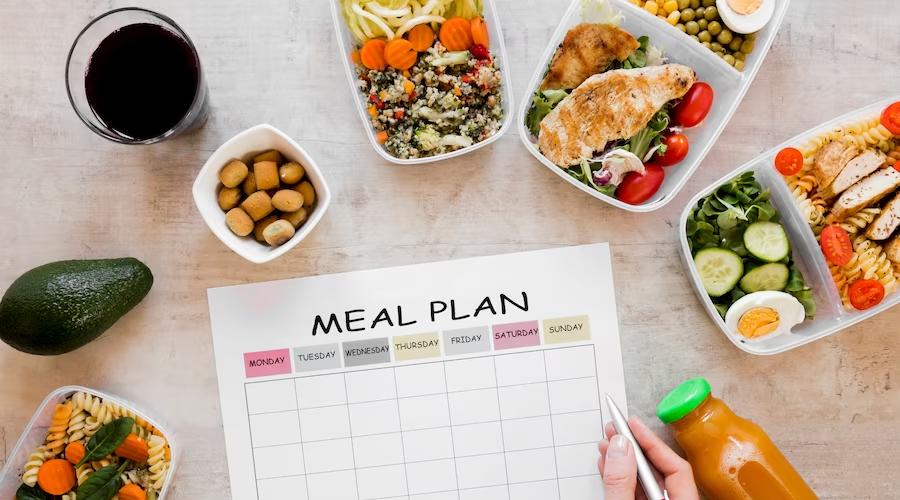Planning a balanced menu can be a challenging task, especially if you are trying to achieve specific health goals or accommodate different dietary needs. The food choices we make play a crucial role in our overall well-being and can impact our physical and mental health in the long run.
Whether you are a seasoned meal planner or just getting started, this post will provide you with valuable tips and tricks for creating a balanced menu that nourishes your body and satisfies your taste buds. From understanding macronutrients to meal prepping and portion control, we will cover everything you need to know to create a well-balanced menu that promotes optimal health and wellness.

The Importance of Balanced Meal Planning
When it comes to meal planning, it’s important to make sure that your meals are balanced and provide your body with the nutrients it needs to function properly. A balanced meal plan includes a variety of foods from all the major food groups in appropriate portions. In this article, we will explore the importance of balanced meal planning and how it can benefit your overall health and wellbeing.
Benefits of a Balanced Diet
A balanced diet that includes all the essential nutrients provides numerous health benefits, including improved digestion, increased energy levels, and better sleep quality. Eating a variety of foods also supports a healthy immune system, can help maintain a healthy weight, and reduces the risk of chronic diseases such as heart disease, diabetes, and certain cancers. In addition, a balanced diet can improve mental health by reducing the risk of depression and anxiety.
- Improved digestion
- Increased energy levels
- Better sleep quality
- Healthy immune system
- Maintaining a healthy weight
- Reduced risk of chronic diseases
- Improved mental health
Understanding Macronutrients for Balanced Meal Planning
Macronutrients are the three main nutrients that make up our diet: carbohydrates, protein, and fat. Each macronutrient has a specific role in the body and it’s important to include all three in your meals for a balanced diet. Carbohydrates provide energy for the body, protein is essential for building and repairing tissues, and fat plays a role in hormone production and nutrient absorption.
When planning meals, aim to include a source of each macronutrient in appropriate portions. For example, a balanced breakfast could include a slice of whole-grain toast with avocado (healthy fat), scrambled eggs (protein), and berries (carbohydrate). It’s also important to consider the quality of the macronutrients. Focus on whole, nutrient-dense foods for optimal health benefits.
- Macronutrients: carbohydrates, protein, fat
- Each macronutrient plays a specific role in the body
- Aim to include a source of each macronutrient in appropriate portions
- Focus on whole, nutrient-dense foods for optimal health benefits.

How to Plan a Balanced Menu
If you want to maintain a healthy lifestyle, planning a balanced menu is a crucial step. It ensures that you are getting all the nutrients you need while also helping you to achieve your health goals. In this section, we will discuss the key steps involved in creating a balanced menu plan that is tailored to your individual needs.
Assess Your Nutritional Needs
Before you start planning your meals, it’s important to assess your nutritional needs. This involves determining the number of calories you need to consume each day and the recommended daily intake of nutrients such as protein, carbohydrates, fats, vitamins, and minerals. You can use online calculators or consult a registered dietitian to determine your specific nutritional requirements.
Tips for Assessing Your Nutritional Needs
- Use online calculators to determine your daily caloric needs based on your age, sex, height, weight, and physical activity level
- Consult a registered dietitian for a personalized assessment and recommendations based on your health goals and medical history
Creating a Balanced Meal Plan
Once you have assessed your nutritional needs, you can start creating a balanced meal plan. A balanced meal plan includes foods from all food groups in appropriate proportions to ensure that you are meeting your daily nutritional requirements. You can create a meal plan for a week or a month, depending on your preference.
Tips for Creating a Balanced Meal Plan
- Include a variety of fruits and vegetables in different colors to ensure that you get a wide range of nutrients
- Choose lean sources of protein such as chicken, fish, tofu, beans, and legumes
- Incorporate whole grains such as brown rice, quinoa, and whole-wheat bread
- Limit your intake of saturated and trans fats, sodium, and added sugars
Tips for Incorporating Variety in Your Meal Plan
Eating the same foods every day can become boring, so it’s important to incorporate variety in your meal plan. This not only keeps things interesting but also helps to ensure that you are getting a wide range of nutrients.
Tips for Incorporating Variety in Your Meal Plan
- Experiment with different cuisines such as Mediterranean, Asian, or Mexican
- Try new fruits and vegetables that you have never tried before
- Use herbs and spices to add flavor to your meals instead of relying on salt or sugar
- Swap out ingredients in your favorite recipes to make them healthier and more nutritious.

Healthy and Balanced Meal Ideas
Creating healthy and balanced meals is an essential part of a healthy lifestyle. Incorporating a variety of nutrient-dense foods is key to providing your body with the necessary vitamins and minerals. It can be challenging to come up with meal ideas that are both healthy and satisfying, but with a little creativity and planning, it can be done.
Vegetarian and Vegan Meal Ideas
A balanced vegetarian or vegan diet can provide all the nutrients your body needs while also being delicious and satisfying. Plant-based protein sources like legumes, tofu, and tempeh can be used to create hearty and filling meals. Incorporating a variety of fruits and vegetables is essential to ensure you are getting all the necessary vitamins and minerals.
- Lentil and vegetable stir-fry with brown rice
- Chickpea and sweet potato curry with quinoa
- Vegan black bean burgers with roasted sweet potato wedges
High-Protein Meal Ideas
Protein is essential for building and repairing muscles, and it also helps to keep you feeling full and satisfied. Incorporating high-protein foods into your meals can be a great way to ensure you are getting enough protein in your diet.
- Grilled chicken breast with roasted vegetables and quinoa
- Salmon with roasted asparagus and sweet potato wedges
- Greek yogurt with mixed berries and almonds
Low-Carb Meal Ideas
A low-carb diet can be a great way to help with weight loss and managing blood sugar levels. Incorporating a variety of non-starchy vegetables, healthy fats, and protein sources can make for delicious and satisfying meals.
- Grilled chicken Caesar salad with avocado and cherry tomatoes
- Baked salmon with roasted broccoli and cauliflower rice
- Zucchini noodles with turkey meatballs and marinara sauce

Tools and Resources for Balanced Meal Planning
Balanced meal planning can be a daunting task, but fortunately, there are many tools and resources available to make the process easier. In this section, we will explore some of the most popular and effective tools for planning and preparing balanced meals.
Meal Planning Apps and Websites
There are numerous meal planning apps and websites available that can help simplify the meal planning process. These apps and websites often provide recipes, grocery lists, and nutritional information, making it easy to plan and prepare healthy and balanced meals. Some popular meal planning apps and websites include Mealime, Paprika, and MyFitnessPal.
Examples of meal planning apps and websites:
- Mealime
- Paprika
- MyFitnessPal
Kitchen Gadgets for Meal Planning and Preparation
Investing in the right kitchen gadgets can make a big difference when it comes to meal planning and preparation. Some essential kitchen gadgets for balanced meal planning include a food scale, measuring cups and spoons, a blender or food processor, and a slow cooker or Instant Pot. These gadgets can help you accurately measure ingredients, prepare healthy meals in advance, and save time in the kitchen.
Examples of essential kitchen gadgets for meal planning and preparation:
- Food scale
- Measuring cups and spoons
- Blender or food processor
- Slow cooker or Instant Pot
The Role of Nutritionists and Dietitians
For those who want more personalized guidance and support with their balanced meal planning, nutritionists and dietitians can be a great resource. These professionals can provide customized meal plans based on individual needs and goals, as well as offer guidance on nutrition and healthy eating habits. They can also help with meal prep and recipe ideas, making it easier to maintain a balanced and healthy diet.
Benefits of working with a nutritionist or dietitian:
- Customized meal plans based on individual needs and goals
- Guidance on nutrition and healthy eating habits
- Assistance with meal prep and recipe ideas

Tips for Sticking to a Balanced Meal Plan
Following a balanced meal plan can be challenging, especially in the beginning stages. However, with some planning and preparation, it’s possible to stick to a balanced meal plan and achieve your nutrition goals.
Meal Prepping and Batch Cooking Tips
One of the most effective ways to stick to a balanced meal plan is through meal prepping and batch cooking. This allows you to prepare meals in advance, making it easier to stick to your nutrition goals and avoid unhealthy temptations. To make the most of your meal prep and batch cooking efforts, consider these tips:
- Choose recipes that are easy to prepare in large batches
- Invest in quality food storage containers
- Plan your meals and snacks for the week ahead
How to Stay Motivated and Accountable
Another important factor in sticking to a balanced meal plan is motivation and accountability. It’s important to set realistic goals and track your progress along the way. Some tips for staying motivated and accountable include:
- Setting small, achievable goals
- Tracking your meals and snacks in a food journal or app
- Finding a workout buddy or accountability partner
Dealing with Cravings and Temptations
Even with the best of intentions, cravings, and temptations can sometimes derail your efforts to stick to a balanced meal plan. It’s important to have a plan in place for dealing with these situations. Some tips for managing cravings and temptations include:
- Keeping healthy snacks on hand for when cravings strike
- Finding healthy substitutes for your favorite indulgences
- Allowing yourself the occasional treat in moderation
FAQ
A balanced meal plan is one that includes a variety of foods from all of the food groups in appropriate portions. This means including fruits, vegetables, whole grains, lean proteins, and healthy fats in your meals and snacks.
Yes! A balanced meal plan doesn’t mean you have to give up your favorite foods. It’s all about moderation and portion control. You can still enjoy treats and indulgences, but in smaller amounts and less frequently.
You can assess the balance of your meal plan by looking at the variety and proportions of food groups included. Aim to include a serving of fruits and/or vegetables in every meal and snack, choose whole grains over refined grains, and incorporate lean proteins and healthy fats. Tracking your food intake using a food diary or app can also help you see if you’re meeting your nutrient needs.
Absolutely! A balanced meal plan is meant to be flexible and adaptable to your preferences and dietary restrictions. You can make substitutions based on your individual needs and preferences while still ensuring that your meals and snacks are balanced and nutritious.
It’s not necessarily required to count calories on a balanced meal plan, but some people may find it helpful for weight management or specific health goals. The most important thing is to focus on the quality and variety of your food choices and ensure that you’re meeting your nutritional needs.




